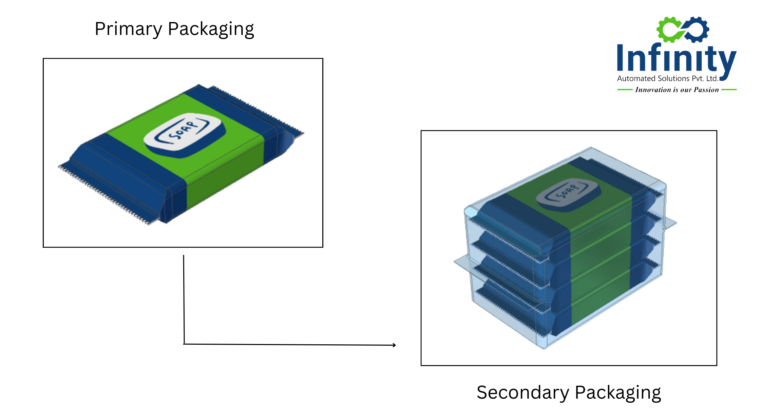Secondary packaging of soap refers to the outer packaging that contains multiple individual units of soap, usually for the purpose of transportation, display, and protection. It serves as an additional layer of packaging beyond the primary packaging, which directly encases each individual soap bar. Secondary packaging can vary in form and materials, and its design often aims to enhance the product’s appeal on store shelves while ensuring that the soap remains intact during shipping and handling.
Secondary packaging of soap types includes:
- Cartons or Boxes: These are usually made of cardboard or paperboard and can hold multiple soap bars. They often have attractive designs, branding, and product information. Cartons or boxes can also be designed with cutouts or windows to showcase the soap bars inside.
- Shrink Wrap: Shrink wrap is a plastic film that is tightly wrapped around a group of soap bars, providing a protective barrier while allowing the product to be visible. Heat is applied to the plastic, causing it to shrink and conform to the shape of the soap.
- Sleeves: Sleeves are paper or plastic coverings that fit around a group of soap bars. They can have eye-catching graphics and branding, and they are slipped over the soap to hold them together.
- Display Trays: Display trays are often used in retail settings to organize and present soap bars. They can be made of cardboard or plastic and have compartments to hold individual soap units securely in place.
- Bags or Pouches: These are often used for specialty or gift soaps. They can be made of various materials such as paper, fabric, or plastic. They can have drawstrings, zippers, or other closures for easy opening and closing.
- Multipacks: Multipacks bundle several soap bars together in a cohesive package. These can be shrink-wrapped or placed in a carton. Multipacks are often used for promotional purposes or to offer a variety of scents or formulations.
- Hang Tags: Some soap packaging includes a hang tag that allows the soap to be hung on a peg display in a retail setting. The tag can provide branding, product information, and instructions.
The secondary packaging of soap depends on factors such as the soap’s target market, branding strategy, cost considerations, and the desired level of protection during distribution. Additionally, there’s a growing trend toward sustainable packaging, so many soap manufacturers are opting for eco-friendly materials and designs in their secondary packaging to minimize environmental impact.
Secondary Packaging of Soap Video
Secondary Packaging of Soap Benefits
Using secondary packaging of soap offers several benefits for both manufacturers and consumers:
- Protection: Secondary packaging of soap provides an additional layer of protection for soap bars during transportation, handling, and storage. It helps prevent damage, breakage, and contamination, ensuring that the soap reaches the consumer in good condition.
- Branding and Marketing: Well-designed secondary packaging serves as a canvas for branding and marketing efforts. Manufacturers can use this space to showcase their logo, product information, benefits, and any promotional messaging. Eye-catching packaging can attract consumers’ attention and influence purchasing decisions.
- Differentiation: In a competitive market, unique and appealing secondary packaging can help soap products stand out from competitors. Creative packaging designs that align with the brand’s identity can create a memorable and recognizable image in consumers’ minds.
- Gift and Presentation: Secondary packaging, such as gift boxes, pouches, or decorative sleeves, adds a sense of elegance and sophistication. These packaging options make soaps suitable for gifting and enhance the overall presentation of the product.
- Convenience: Packaging solutions like multipacks or display trays can make it easier for consumers to purchase and store multiple soap bars together. This convenience can encourage larger purchases and repeat business.
- Retail Display: Secondary packaging of soap is designed to be visually appealing, making it suitable for in-store displays. Retailers can use these packaging options to create attractive shelf presentations and highlight specific soap collections.
- Information Sharing: Packaging provides space to communicate important information such as ingredients, usage instructions, safety precautions, and environmental considerations. This helps consumers make informed choices and ensures product compliance with regulations.
- Sustainability: Many soap manufacturers are adopting sustainable packaging practices by using eco-friendly materials and reducing waste. This not only aligns with consumer preferences for environmentally conscious products but also contributes to a positive brand image.
- Product Cohesion: Secondary packaging of soap can bundle multiple soap bars together, making it easier for consumers to purchase sets or multipacks. This can also lead to higher average transaction values.
- Protection from Tampering: Some secondary packaging options, such as shrink wrap or sealed boxes, can provide tamper-evident features that reassure consumers about the product’s safety and integrity.
- Extended Shelf Life: Packaging can help preserve the freshness and quality of the soap by providing a barrier against external factors like humidity, dust, and light.


